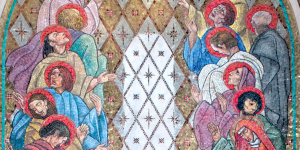
During the month of May, the Church celebrates many saints with feast days and memorials, honoring their unique contributions to the faith and reflecting on their examples of holiness. From brave missionaries like Damien of Molokai to the disciple who replaced Judas, these saints each have something to teach us. Read about four saints celebrated in May and why you should know their stories.
May 10 – St. Damien of Molokai (Jozef Damien De Veuster)

St. Damien of Molokai (Jozef Damien De Veuster) was born in Tremelo, Belgium, on January 3, 1840. At age 23, young Damien set sail for the Hawaiian Islands eager to share the Gospel and arrived over a year and a half later. During his time there, an influx of British and American merchants brought new difficulties to the native Hawaiians, including European diseases which slashed the population from 300,000 to about 50,000. When an epidemic of leprosy broke out, government leaders on the island sent the infected to live in quarantine on the island of Molokai, using armed officers to forcibly remove those who would not cooperate. Damien pleaded with local authorities, but to no avail. Heartbroken by how the tragedy had ripped families apart, Damien decided to go to Molokai to care for the lepers, understanding that he could never come back.
When Damien arrived in 1873, there were 800 lepers on the island and lawlessness was rampant. Damien brought order to the chaos, providing critical infrastructure and spiritual encouragement. He arranged funeral ceremonies and burials, encouraged the islanders to grow their own gardens for healthy nutrition, and built huts and a church. Damien even engineered his own irrigation system for the island. Unlike the doctors, who weren’t brave enough to come into contact with the afflicted, Damien cared for the sick himself.
In 1885, Damien began to develop leprosy himself. However, he remained steadfast and gracious throughout it all, continuing to serve until his death in 1889. “If I didn’t have the continual presence of the divine Master in my poor chapel, I could not persevere in my decision to share the lot of the lepers,” he said. Today, St. Damien’s selflessness and compassion for others continue to serve as an inspiration to the faithful around the world.

May 14 – St. Matthias
After Judas Iscariot betrayed Jesus, the disciples appointed another man to serve alongside them as they strove to fulfill the Great Commission that Jesus had given them. Though we do not know much about the man they chose, we know that his name was Matthias, and that he was a godly man who had witnessed much of Jesus’ earthly ministry.
Once Jesus had ascended into heaven, the disciples gathered to choose a replacement for Judas Iscariot. They cast lots between Barsabbas and Matthias, and the lot fell upon Matthias. Though he was not necessarily present for the Great Commission, Matthias was present when the Holy Spirit descended on the day of Pentecost. Equipped with the power of the Holy Spirit, he served alongside the other disciples, spreading the good news of the Gospel. Tradition holds that he served in Cappadocia (modern Turkey) and later, along the Caspian Sea, where he was martyred.
May 22 – St. Rita of Cascia

Born in 1381 in the town of Roccaporena, Italy, Margherita Lotti expressed a desire for holy life from a young age. However, when she was only 12 years old, her parents arranged for her to be married against her wishes. Despite her husband’s emotional and physical abuse, Margherita remained faithful and gave birth to twin sons within a year of their wedding.
Over time, Margherita’s husband learned to be a kinder man, but 18 years after their marriage, he was killed by adversaries from his past. About a year later, she also lost her two sons to dysentery. Widowed and childless, she sought refuge at the Monastery of Saint Mary Magdalene in Cascia and dedicated herself wholeheartedly to work at the convent. While she could often be found advising lay-people and tending to ailing nuns, she would also find time to reflect on the Passion of Christ. Margherita died after a long struggle with tuberculosis that confined her to bed for the final four years of her life, during which she subsisted almost exclusively on the Eucharist.
Nearly 450 years later, Saint Rita was canonized on May 24, 1900, by Pope Leo XII. She is recognized as the patron saint of difficult marriages, parenthood, and impossible causes.
May 25 – St. Mary Magdalene Pazzi

On April 2, 1566, Mary Magdalene de Pazzi was born into a noble Italian family in Florence. Originally named Caterina, Mary demonstrated a kind and charitable nature from her youth, expressing a fervent love for prayer, penance, and the Blessed Sacrament. After convincing her parents to let her become a nun, she joined the Carmelite convent of Santa Maria degl’ Angeli in December of 1582. In January 1583, she received her habit and changed her name to Mary Magadalene de Pazzi, and in March of the following year, she was afflicted with a terrible illness. By May of 1584, it was believed that she would soon die, so at her request, she was transported on a stretcher to make her profession on May 27, the Feast of the Trinity.
Upon making her profession, Mary underwent a 40-day mystical experience which nearly ended in her death, and for the next five years she suffered through “inward desolation and temptations.” However, these trials did not prevent her from completing her duties at the convent, and even served to inspire and strengthen other members who witnessed her courageous resilience in the face of deep suffering. Mary never fully recovered her physical health, but she continued to teach and serve as a mistress to incoming and junior nuns, eventually being appointed superior in 1604.
During her time as mistress and superior, she came to be known as a wise, disciplined, and giving woman, who was much loved by all who knew her. In 1607, after three years of further physical torment, Mary succumbed to consumption and passed away. Her life continues to serve as a source of inspiration to Catholics across the world, and her incorrupt body can still be viewed by pilgrims in Italy today.

